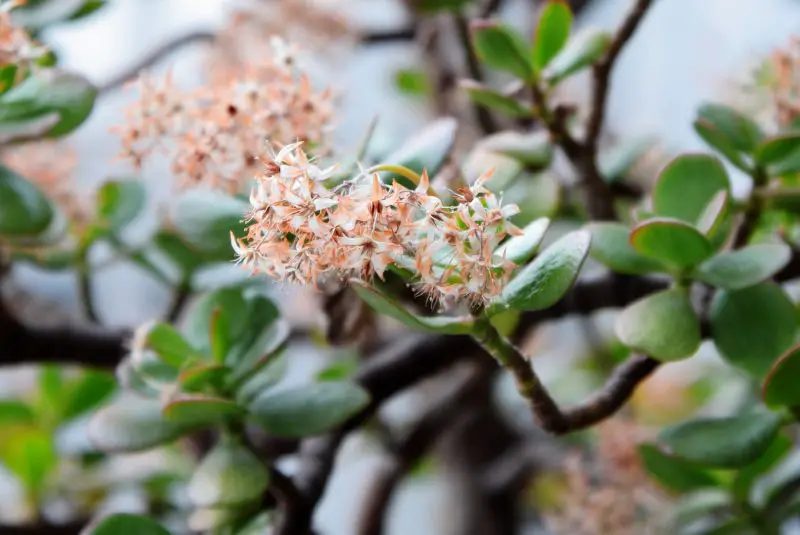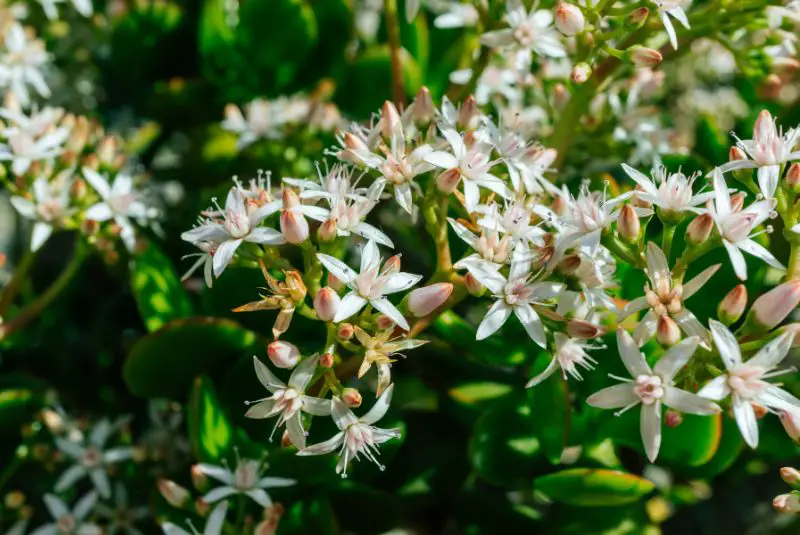My Secret Hacks To Get Your Jade Plant To Flower
Ever wondered why your jade plant refuses to show off its blooms, despite all your love and care? Well, turns out, jade plants are a bit like that elusive friend who only shows up when the conditions are just right.
They can thrive for years without blooming, and it’s not because they’re shy—it’s because they’re picky.
Getting a jade plant to flower is like trying to get a cat to fetch: it’s possible, but it requires some clever strategy.
You’ve got to recreate their native habitat, which means giving them a little bit of tough love. Think dry, arid conditions and cooler nights. And let’s not forget, they need to be mature enough to even consider blooming. S
o, if you’re ready to coax those elusive flowers out, stick around—I’ve got the lowdown on how to make it happen.

Necessary Conditions for Flowering
To get your jade plant to bloom, specific conditions must be met, ensuring the plant mimics its natural habitat. Here’s what you need to know:
Importance of Plant Maturity
Jade plants need to reach a certain maturity level to flower. Typically, they start blooming when they grow to about 40cm high. Younger plants don’t have the needed maturity for this process. If your jade plant is still young, focus on keeping it healthy and let time do its work. Mature plants have the right energy reserves and stability to support flowering.
Adequate Sunlight Exposure
Light is key to the blooming process. Place your jade plant in a bright spot, ensuring it gets as much sunlight as possible. For optimal growth, position it near south or west-facing windows, where it can soak up direct light. Even in winter, maintaining light exposure is essential; inadequate light means no flowers.
Appropriate Temperature Ranges
Your jade plant prefers cooler temperatures, especially during the winter months. Keep it in a place where temperatures stay below 11°C (52°F). This period of low temperatures mimics the plant’s natural environment, signaling it to prepare for blooming. During summer, placing the plant outdoors can help, but remember to bring it back inside before the colder autumn nights set in.
Optimal Care Techniques to Induce Blooming
Optimal care practices play a key role in getting jade plants to bloom. From watering habits to soil types and seasonal adjustments, each factor impacts the plant’s readiness to flower.

Watering Practices
Maintaining the right watering schedule is key for a jade plant’s health. Overwatering leads to root rot, while underwatering stresses the plant. In summer months, water once a week or when the top inch of soil feels dry. During winter, reduce watering to once every two to three weeks since the plant goes into dormancy and requires less moisture.
Using the Right Soil Mix
The soil mix influences the plant’s ability to take up nutrients and water efficiently. Use a well-draining cactus or succulent mix to ensure roots don’t sit in water. A good mix includes ingredients like perlite, coarse sand, and pine bark fines. This blend keeps the soil airy and prevents water from accumulating at the roots.
Seasonal Care Adjustments
Adjusting care routines based on seasonal changes helps jade plants thrive. Place the jade plant in a spot with bright sunlight during summer, like near south or west-facing windows. In winter, keep it in a cooler room with temperatures below 52°F (11°C) to encourage blooming. This temperature drop signals the plant to prepare for flowering.
Encouraging Stress for Flowering
Jade plants often need a bit of stress to trigger blooming. This stress mimics their natural environment and promotes the growth necessary for flowering.

Why Beneficial Stress?
Stress in jade plants encourages flowering by mimicking survival conditions. In the wild, jade plants face periods of drought and limited space. These conditions force them to reproduce through flowering to ensure survival. If you stress your jade plant just enough, it responds by trying to flower.
- Limit Watering: Allow the soil to dry out completely between waterings. Water sparingly and don’t worry if the plant seems a bit thirsty. This replicates the arid conditions jade plants experience in nature.
- Restrict Pot Size: Keep your jade plant in a pot that’s slightly cramped. Jade plants grow better when rootbound, and a smaller pot limits root expansion, encouraging the plant to flower instead.
- Adjust Light Exposure: Place your jade plant in bright indirect light, especially in winter. During summer, partial shade helps simulate their native environment. Watch for signs of too much direct sunlight, like leaf scorch, and adjust accordingly.
- Temperature Fluctuations: Expose your jade plant to cooler temperatures at night during winter, ideally around 55°F (13°C). This dramatic temperature shift can stimulate flower production.
By integrating these techniques, you’re setting the stage for your jade plant to bloom, making it more alive and vibrant.
Advanced Care: Fertilization and Pruning
Choosing the Right Fertilizer
Regular fertilization plays a key role in getting jade plants to flower. Opt for a balanced, water-soluble fertilizer with an equal ratio of nitrogen, phosphorus, and potassium (e.g., 10-10-10). This mix provides the essential nutrients jade plants need. Apply the fertilizer once a month during the growing season, from early spring to late summer.
Mix the fertilizer at half the recommended strength to avoid overfertilizing, which can harm the plant. Overfeeding leads to salt buildup in the soil, negatively impacting root health. Using a more diluted solution ensures that the plant absorbs nutrients gradually. Additionally, incorporating a slow-release fertilizer into the potting mix at the start of the growing season can offer consistent nourishment.
Pruning for Health and Bloom Enhancement
Pruning is not just for maintaining the shape of the jade plant; it’s essential for overall health and promoting blooms. Cut right above a leaf node, which is where new growth will emerge. This technique encourages a bushier plant and helps remove any dead or damaged growth that saps energy. Remove these parts carefully to prevent injuring healthy branches or new buds.
Regularly prune to improve air circulation around the plant, reducing the risk of disease. Removing spent blooms, also known as deadheading, redirects the plant’s energy into producing new flowers rather than seeds.
Prune to maintain the desired shape and size but avoid overpruning. Excessive cuts can stress the plant, resulting in fewer blooms. It’s all about finding the right balance to help the jade plant thrive both in appearance and health.
Troubleshooting Common Blooming Issues
Even with the best care, jade plants sometimes refuse to bloom. Figuring out what went wrong helps get back on track.
Lack of Flowers Despite Optimal Conditions
If the jade plant isn’t flowering despite providing optimal conditions, it’s time to double-check some factors. Sometimes, minor oversights prevent blooming. Ensure the plant receives at least 8 to 12 hours of bright, direct sunlight daily. If needed, supplement with grow lights.
Check for nutrient imbalances. Using a balanced, water-soluble fertilizer once a month during the growing season can support bloom production. Over-fertilizing or under-fertilizing disrupts this balance, affecting blooming.
Reassess the watering routine. Jade plants thrive when watered deeply but infrequently. Allow the soil to dry out between waterings and avoid waterlogged conditions, as this promotes root rot and inhibits flowers.
Overcoming Environmental Challenges
Environmental challenges such as inconsistent temperatures, poor lighting, or improper humidity levels can hinder blooming. Jade plants prefer temperatures between 65°F and 75°F during the day, with a slight drop at night. Sudden temperature changes or drafts stress the plant, reducing the likelihood of flowering.
Evaluate the pot size. Sometimes keeping plants slightly root-bound encourages blooming. If the plant seems too comfortable in its current pot, consider allowing it to become slightly root-bound before repotting.
Regularly inspect the plant for pests and diseases. Mealybugs and fungal infections cause damage and stress the plant. Use insecticidal soap for pests and appropriate fungicides for diseases.
By addressing these common blooming issues, the jade plant stands a much better chance of producing beautiful flowers.